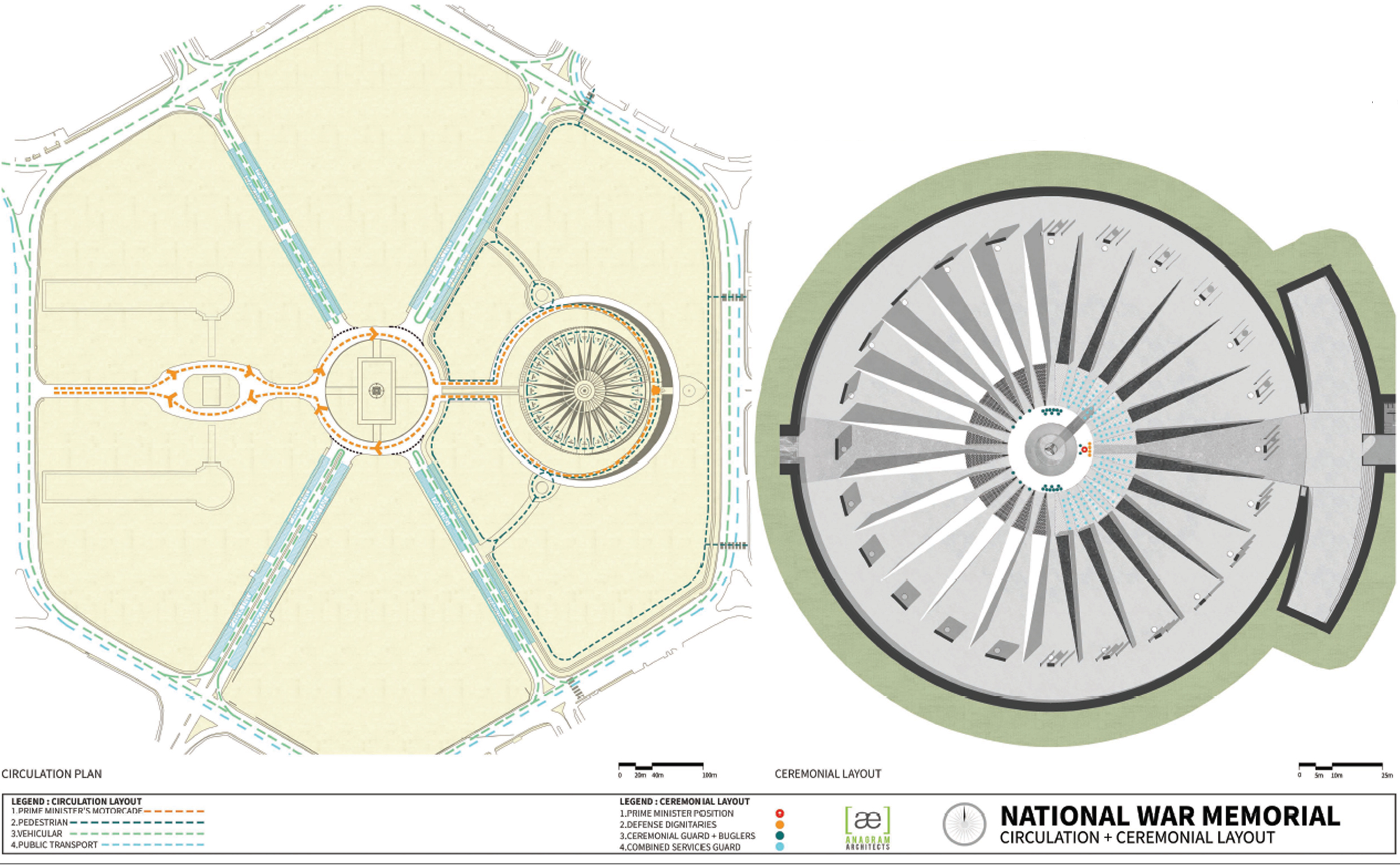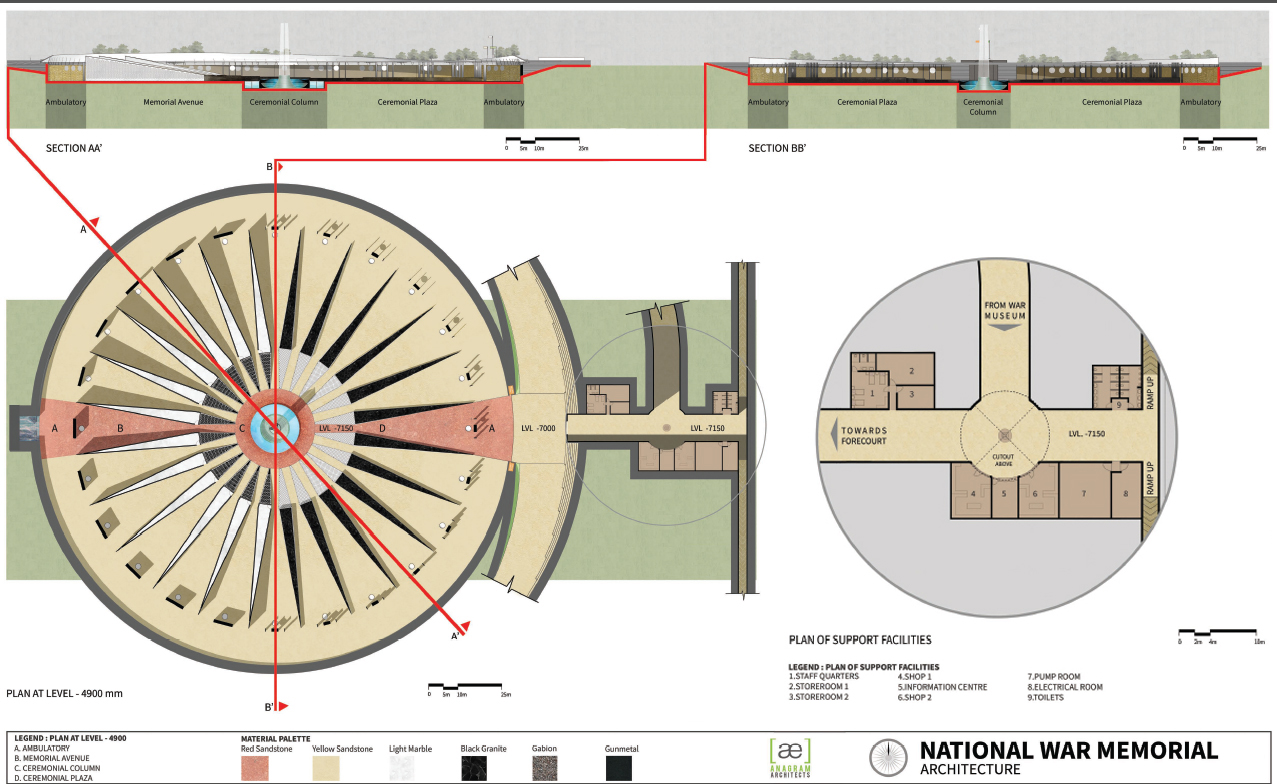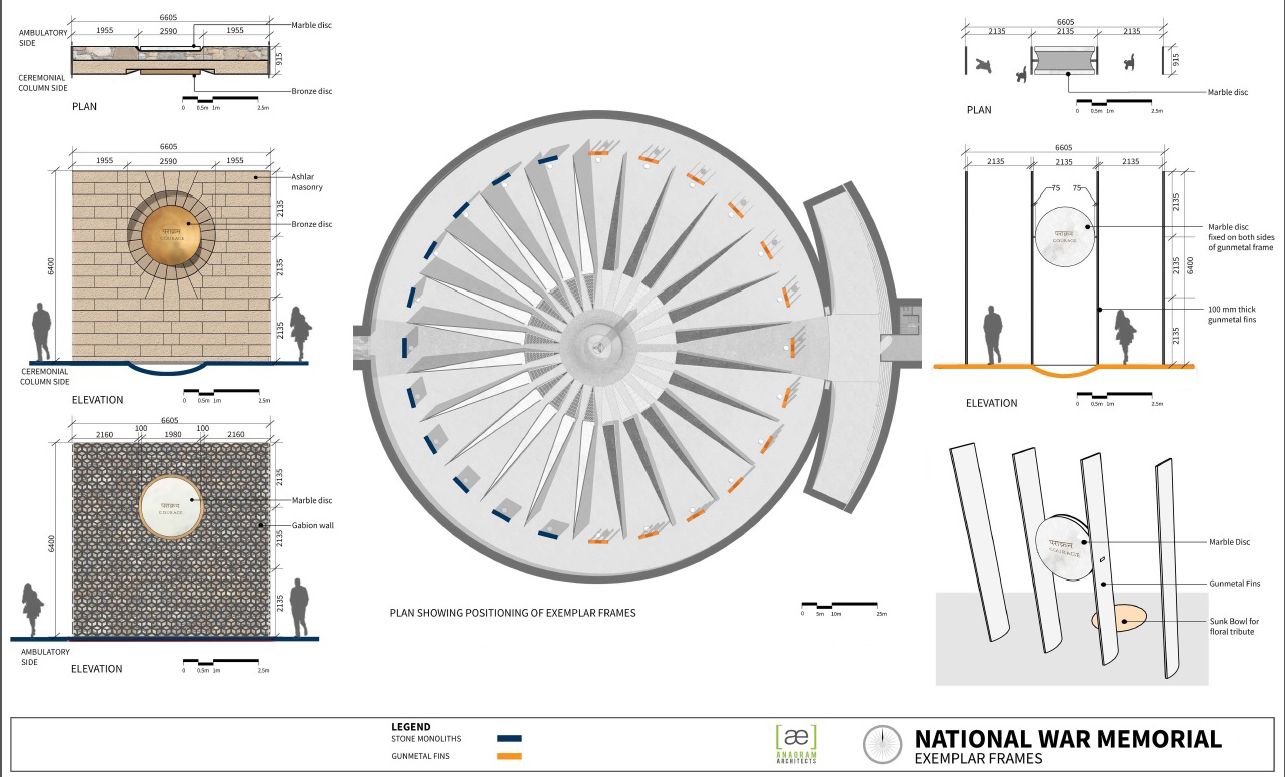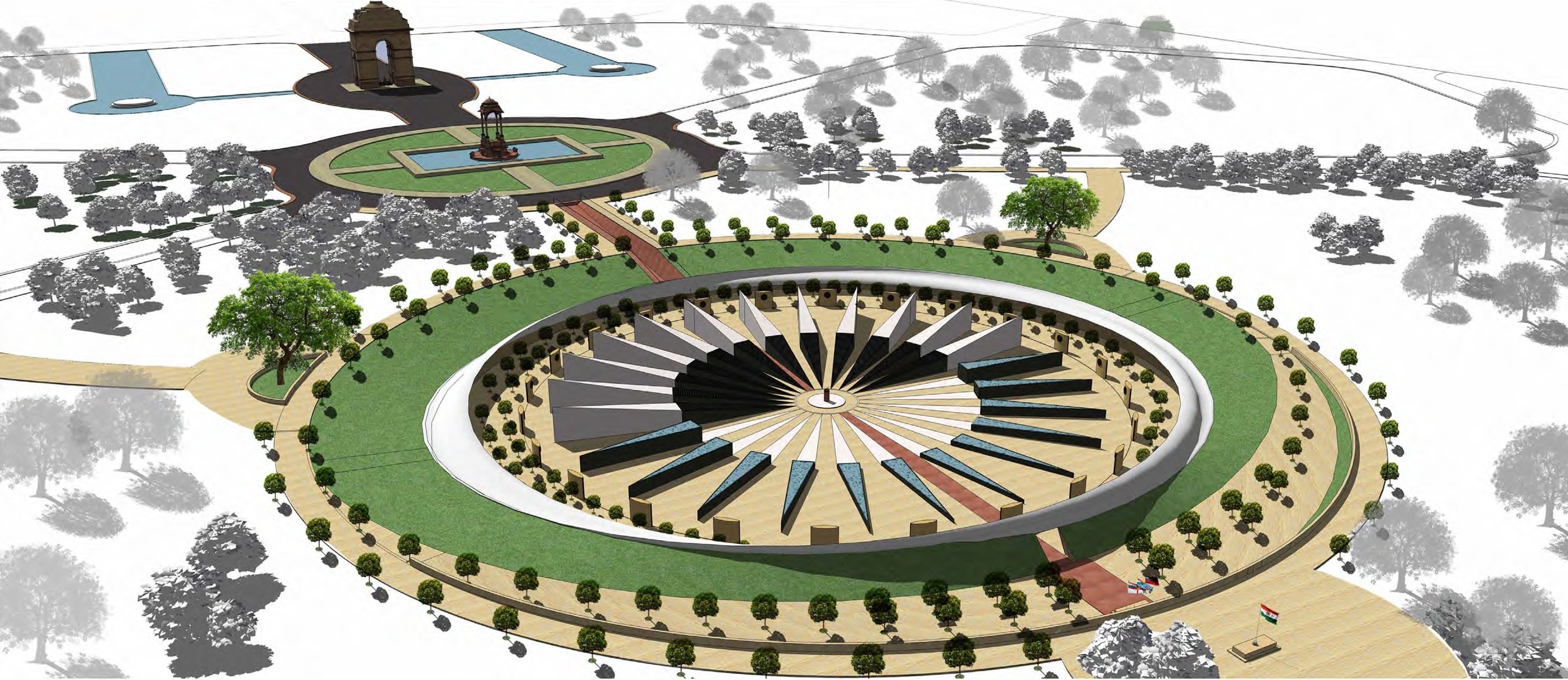The design is an architectural elaboration of the Dharma chakra – the wheel of duty, law and righteousness. This is a fundamental symbol in our national imagination, recast here as a dynamic form attuned to the geometries of its precinct.
The proposed monument aims to draw a grateful nation to reflect on the magnitude, ardour and timelessness of the ultimate sacrifice made by India’s military martyrs.
Dharma Chakra – The eternally turning wheel of duty, law and righteousness is fundamental to lndic philosophies. The 24-spoked Asokan Dharmachakra represents the path to release from death and birth. The official national emblem of India and central emblem on the national flag, it is a prominent feature of the Asokan Lion Capital.
Citta-santana – literally ‘the stream of mind’ – is the stream of succeeding moments of mind or awareness. It provides continuity from one life to the next, akin to the flame of a candle which may be passed from one candle to another.
Santana (Sanskrit) holds the semantic field of ‘eternal’, ‘continuum’, ‘a series of momentary events’ or ‘life stream’. The mind stream (santana) increases gradually by mental afflictions (klesa) and by actions (karma), and goes again to the next world. In this way the circle of existence is without a beginning or an end.
These translate to three guiding principles that have moulded the design:

Dharma (as duty) – The lndic concept of Dharma is complex and perhaps best revealed through the 24 dharmic qualities that replace the idea of the self with a notion of unity or oneness. Ranging from bravery to empathy, these qualities are exemplified by a soldier’s ultimate sacrifice and engendered by an unflinching, patriotic devotion to Dharma.
Kala (as time) – Time is believed to be both cyclical and historical, to do with cosmological patterns and with human contingencies. Consciousness of time and its many intersections – the time of our ancestors and our own, periods of peace and occasions of conflict – shapes our sense of being. Our sense of time provides a shared horizon for reflection. It is over time that we protect and project ideals that have been hard-won, and ideals that are repeatedly negotiated.
Dharti (as landscape) – Evoking popular association with the landforms that define the territory of India, the memorial represents the nation as a landscape, rather than a territorial map. The peaks of the Himalayas, rivers and waterfalls, the vast plains and dazzling desert dunes, blackstone plateaus of the Deccan – these are some key points of architectural reference. Built close to the ground, the structure embodies humility, and the deference owed to thousands who have sacrificed life and kin to the protection of their land.
Site and Context:
The National War Memorial is visualised within the context of the Central Vista and C-hexagon. Special emphasis is paid on achieving a clear fit with the geometry of the Lutyens’s heritage zone. Running east-west, the Central Axis is reinforced by the primary spine of the design, which occupies Lawns II & III. Articulated in red sandstone, this axis aligns the Memorial’s ceremonial column and hub with the C-hexagon’s central chhattri and India Gate beyond. Secondary cross axes are formed with the fountains located on either side of India Gate. At the two focal points are envisioned powerfully figurative sculptures that represent known military martyrs.
Retaining major existing trees, additional planting creates a symmetrical affinity with the existing landscape. The memorial is sunk into the ground such that no part of the structure is more than 1.5m above the groundline.
From the lawns, two wide slopes drop down gradually to the wide entrance forecourt of the Memorial, where the underground tunnel connected to the proposed museum – as well as the pedestrian ramps from the eastern broadwalk – emerge. Transplantations and fresh plantations of trees are envisaged along the footpath at the periphery of Lawns II & III. The lawns themselves are intended to continue as open public greens (maidans) and serve as precious urban assets.
The C-hexagon experiences fastest moving traffic at the periphery of the lawns – the design gently filters out pedestrians into its quiet premises through the eastern broadwalk that serves as a linear collector for pedestrians, crossing from the other side of the road. Peripheral pedestrian movement is further encouraged by the plantation along the road, providing shade. Private vehicular and para-transit movement is directed to the two parking lots existing north and south of the Chhatri where appropriate drop-offs have been provided. An exclusive special movement path for VVIP motorcades or cavalcades is also envisaged.

On the west, toward India Gate, the retaining gabion wall cleaves open to a 10m wide and 100m long water cascade in red sandstone, rising back up to road level. An underground tunnel from the proposed National War Memorial is envisaged to open up within the monument from the North.
Design and Features:
The memorial is built in an 81m wide sanctum, sunk 7m below road level. From the surrounding lawns it may be approached by two wide, sloped aisles, an underground tunnel connected to the proposed museum and a pair of pedestrian ramps dropping down from the eastern public broadwalk. The latter two lead in through a sunken court, around which are housed support facilities.

One enters from a forecourt flanked by a gently arcing theatre of risers, into a 12m wide ambulatory fenced by 24 markers bearing plaques of dharmic exemplars. Past these lies a sweeping vista of 24 radial monoliths. 12 of these are pools of placid water, gently ascending from under 1m to just over 2m in height, reflecting the presence of the armed forces in peacetime. At the centre of this plaza is a tall, tapering, self-supported glass column. This spire shoots upward above an eternal flame that burns on a plinth of stacked glass.
Mirroring the pools, the other 12 monoliths rise to a height of 8.5m, their walls bearing the names of the martyrs on marble tiles. Water cascades in black granite flow down toward the central column, evoking the movement and tumult of wartime. The spaces between these 12 skyward monoliths form intimate avenues that allow a more personal remembrance of martyred kith and kin.

The layout of the sanctum allows for a fan-like arrangement of 6 buglers and an 18-member ceremonial guard at the memorial column. Appropriate arrangements for the movement and static positions of various dignitaries – including the Hon’ble President, Prime Minister and Minister of Defence – have been made in the design, for wreath-laying and ceremonies, as well as arrangements made for live broadcast from multiple angles without requiring crews to be unduly close to the principal participants. Further, the design, lends itself to stunning aerial shots.
While the sanctum is timeless, the tree-lined Eastern broadwalk girdling the monument’s road edge is designed to be a legible timeline, commemorating specific battles that epitomise the gallantry of Indian forces. The timeline is marked by periodic change in paver stone and commemorative signage along the kerb.

The Mobius canopy: The topological continuity of the canopy serves as a metaphor for the infinite turning of the Dharma Chakra. Held aloft by a toroidal earth berm that gradually flattens and dips towards the entrance, the canopy structure encircles the Memorial plaza, providing rain cover and shade to the wide ambulatory passage along the monument’s periphery. It serves also to visually frame and connect the sunken core of the Memorial with the surrounding landscape, creating a dynamic skyline from within the space. The canopy is made of gunited concrete sprayed on a continuous twin helical foil arrangement of mild steel frames that are cross-braced every 4m. The entire system is held 1m above the retaining wall on a continuously undulating arrangement of twin mild steel pipe section struts.
Materials and Technology:
The 24 framing structures in the sanctum are split in two groups: stone monoliths, and gunmetal fin clusters. The walls are constructed in rubble gabion on their outward face (procured from the different regions of the country and representing diversity) and in sandstone ashlar on the inward face (representing the secular credentials of a uniform fighting force). A shallow bowl-shaped depression is carved out in front of each exemplar allowing visitors to pay floral homage at the far end of each memorial avenue.
The light marble tiles bearing the names off martyrs are fixed to a tertiary structure of Stainless Steel C-channels, and may be removed and replaced with a named tile in military ritual. The names on these tiles are engraved upto a depth that allows for the inscription to be backlit at night-time but remain easily visible during daytime as well. The SS channels are supported on MS fins placed upto a metre apart, and also support the primary truss structure and prevent deviations. The roof is made of concrete poured onto corrugated steel decking.
 Thick yellow and red sandstone form the primary flooring material – ensuring enough thermal mass to absorb incidental solar thermal gain during the summer day, and releasing it by night when the footfall is low.
Thick yellow and red sandstone form the primary flooring material – ensuring enough thermal mass to absorb incidental solar thermal gain during the summer day, and releasing it by night when the footfall is low.
The linear water cascades to the west are made of masonry and concrete topped with tessellating tiles, and house individual reservoirs and pumps. The water bodies are designed to provide adiabatic evaporative cooling, dropping the ambient air temperature by upto 3° C during the summer through natural evaporation, that would increase the moisture content in the air as well. In the humid months, the ventilation is enhanced by a simple heat exchanger and ventilator. Installed within the water reservoir below ground, the system uses natural temperature difference (air to water) to drive a gentle breeze through the centre of the ceremonial plaza. An access door is provided at their leading edges to provide access to the steel structure for servicing the lights and electricals.
 The canopy – made from ferrocement – is embossed with undulations to evoke the images of windswept desert dunes, while the retaining wall below is treated to represent the geological diversity of the country.
The canopy – made from ferrocement – is embossed with undulations to evoke the images of windswept desert dunes, while the retaining wall below is treated to represent the geological diversity of the country.
A system of water channels and storage sumps would collect rain water and dew year round; the system would draw functional and aesthetic strength from India’s traditions of water management.













